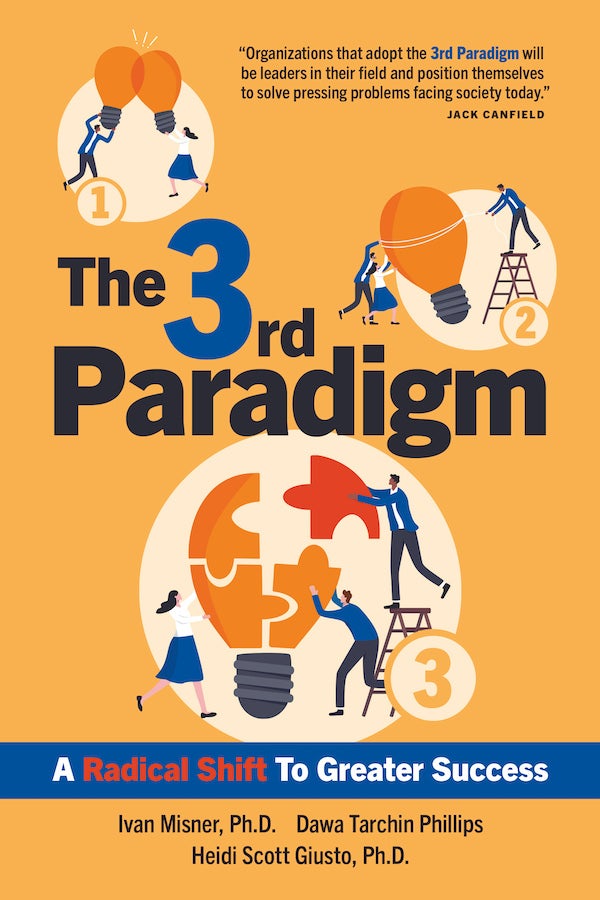Opinions expressed by Entrepreneur contributors are their own.
Co-creation involves knowing how to collaborate in a way that gets the best out of your partners and yourself. In this excerpt from our new book, The Third Paradigm: A Radical Shift to Greater Success, my co-authors, Dr. Heidi Scott Giusto and Dawa Tarchin Phillips, and I explain how to gain buy-in and consensus as a leader, and move projects forward despite any challenges that may arise.
Leaders as Vision Champions
The real-world application of any concept is critical if you want it to truly impact people and the company they work for. It takes a special type of leader to execute co-creation. Leading a co-creative process must begin by displaying a quiet confidence in everyone else’s abilities. Co-creative leaders are somewhat like conductors of a symphony. Their role is to unify the performers, set the tempo, and keep the orchestra playing in time and in sync. In effect, they are the vision champions. They maintain the big picture of the overriding objective while allowing everyone to add their unique contributions to the crowdsourced result.
Buy The Third Paradigm: A Radical Shift to Greater Success | Entrepreneur Bookstore | Amazon | Barnes & Noble
As the world becomes ever more complex and interconnected, the traditional top-down approach to leadership is no longer effective. To create lasting change, leaders must learn to co-create with their teams by identifying team members’ strengths, creating a safe environment where everyone feels heard and respected, and leveraging their abilities to achieve collective success.
Leaders can hold the vision in many ways:
- By clarifying expectations. Leaders must be clear about what they want to achieve and why it’s important. They must also be open to input from all team members. Only then can the team reach consensus and move forward together—and, as always, in alignment with the overarching vision.
- By leveraging contextual intelligence. Leaders must be able to adapt their plans and strategies when circumstances change. They must also be able to identify potential saboteurs and manage conflict effectively.
- By asking questions. Leaders can derive great value from co-creative teams simply by asking good questions. When do we want to get this done? When do we want to make this decision? What is our ultimate goal for this project? What is stopping us from achieving this success? Routinely asking good questions has the effect of reinforcing consensus and ensuring a cohesive vision among all stakeholders.
- By leading from behind—and with guardrails. Sometimes leading a co-creative process can seem like your team is running on a field, and you are running behind them, hollering, just trying to keep them inside the boundaries. In fact, co-creation often means leading from behind. That ensures the leader can keep the big picture—the vision, the boundaries—in mind while everyone is working their way down the field. This approach also positions the leader to gather as much input and extract as much value as possible from each team member.
- By coaching and cultivating. Leaders must relinquish control and focus instead on coaching others to perform at their best. By identifying each team member’s strengths, the leader can position them to contribute based on their individual talents.
- By communicating. Clear and effective communication is necessary among all stakeholders for co-creation projects to succeed. We believe in the communication saturation approach that Richard modeled in our co-creation story.
Positioning the leader as the vision holder in a co-creative process also helps destroy the old model of command and control—of lead, follow, or get out of my way—and help everyone embrace this 3rd Paradigm.
Above all else, the leader must be an example for others to follow. They must be open-minded, respectful, professional, nonjudgmental, humble, transparent, and appreciative. More than that, their actions must embody the project’s vision—the mutually desired outcome. Otherwise, they will drag the entire process down. Our open-ended survey of over 4,000 business professionals contained an astounding 1,945 mentions of the word “leader” when discussing the benefits and drawbacks of co-creation. And these responses were NOT to questions about leadership. Strong leaders are crucial to a successful co-creative process.
Related: Best Business Books for Entrepreneurs
Barriers to Execution
Even when leaders are committed to holding the vision throughout co-creation, internal barriers can emerge—emotional and psychological ones—that can crop up and cause problems for you. If you are leading a co-creative process, be wary of the following issues:
- Procrastination. Co-creation is a dynamic and sometimes messy process. Kicking the can down the road only ensures co-creation won’t happen. Don’t succumb to the impulse to put things off.
- Lack of transparency. Execution of co-creation must be transparent. Co-creation will fail if you are not transparent with all stakeholders.
- Denial and/or avoidance. Denying there is a problem, miscommunication, or any other issue almost guarantees poor morale. Trying to avoid dealing with a problem only creates more problems.
- Perfectionism. LinkedIn co-founder Reid Hoffman has said, “If you’re not embarrassed by the first version of your product, you’ve launched too late.” If you demand perfection from your team, the co-creative project will almost certainly fail. Always strive for further improvement, but never let imperfections restrict the co-creative process.
- Lack of humility. Humble people don’t think less of themselves, they just think of themselves less. The lack of humility can be a problem for co-creation because it can lead to individuals prioritizing their own ideas and perspectives over those of others, hindering collaboration and stifling creativity. Additionally, a lack of humility can create a competitive and confrontational atmosphere, which can ultimately impede progress toward the shared goal.
Leaders must not only hold the vision of the co-creative project, but they must also hold themselves accountable. Recognizing and dealing with these barriers is a good place to start.
Buy The Third Paradigm: A Radical Shift to Greater Success | Entrepreneur Bookstore | Amazon | Barnes & Noble




